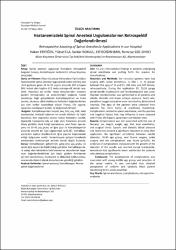Hastanemizdeki spinal anestezi uygulamalarının retrospektif değerlendirilmesi
Özet
Amaç: Spinal anestezi uygulanan hastaların retrospektif
bulguları tarayıp, komplikasyon nedenlerini ortaya koymayı
amaçladık.
Gereç ve Yöntem: Afyon Kocatepe Üniversitesi Tıp Fakültesi
hastanesinde spinal anestezi uygulanarak opere edilmiş ASA
I,II,III grubuna giren 16 ile 91 yaşları arasında 247 si bayan
365 i erkek olan toplam 612 hasta retrospektif olarak incelendi.
Hastalara ait veriler hasta dosyalarından anestezi
gözlem formlarından ve kendilerinden toplandı. Spinal
anesteziye bağlı gelişebilecek komplikasyonları ve buna
olumlu, olumsuz etkisi olabilecek faktörleri değerlendirmek
için tüm veriler istatistiksel olarak T-testi, Chi square,
spearman korelasyon testleri ile değerlendirilmiştir.
Bulgular: Komplikasyonlar cinsiyet, boy, kilo, yaş, ASA, lokal
anestezikler, fentanil kullanımı ve cerrahi klinikler ile ilişkili
bulunmaz iken uygulama sonrası bütün hastaların sistolik,
diyastolik tansiyonlarında ve kalp atım hızlarında anlamlı
düşüş görüldü. Ayak bileği operasyonu, anal fissür operasyonu
ve 35-45 yaş grubu ve iğne çapı ile komplikasyonlar
arasında anlamlı bir ilişki saptanmadı (p<0,05). Komplikasyonlardan
sadece bradikardinin iğne çapının büyümesiyle
arttığı bulgusuna varıldı. Komplikasyon gelişen hastalarda
anesteziden memnuniyet anlamlı olarak düşük bulundu.
Sonuç: Komplikasyon gelişiminin; genç-orta yaş grubu ve
spinal iğne seçimi ile ilişkili olduğu görüldü. Komplikasyonlara
sebep olan faktörlerin belirlenmesi ve tedavilerinin başarısını
değerlendirebilmek için hasta gözlem formlarının
ayrıntılı hazırlanması, muntazam ve dikkatlice doldurulması,
sonrasında düzenli olarak dosyalanması gerektiği görüldü. Aim: To scan retrospective findings in patients undergoing
spinal anesthesia and putting forth the reasons for
complications.
Materials and Methods: We recruited patients have had
surgery with spinal anesthesia, in ASA I, II, III groups
between the ages of 16 and 91, 365 male and 247 female,
retrospectively. During the application 22, 25,26 gauge
spinal needle, bupivacaine and levobupivacaine was used.
Standart monitorization was performed to all patients and
sistolic, diastolic and mean arteryal pressure; heart rate,
peripheral oxygen saturation were recorded by deterimined
intervals. The data of the patients were collected from
patients file, from forms of anesthesia monitoring.
Complications related to spinal anesthesia, and the positive
and negative factors that may influence it were assessed
with T-test, Chi-Square, spearman’s correlation tests.
Results: Complications was not associated with the use of
fentanyl, sex, height, weight, age, ASA, local anesthetics,
and surgical clinics. Systolic and diastolic blood pressure
and heart rate showed a significant reduction in rates after
application. No significant correlation between needle
diameter, 35-45 age group, anal fissure surgery, ankle
surgery and the complications was found (p<0,05). No
evidence of complications increased with the growth of the
diameter of the needle was reached except bradycardia.
Anesthesia had significantly lower satisfaction for patients
who develop complications.
Conclusion: The development of complications was
associated with young-middle age group, and selection of
the spinal needle. It was concluded that detailed
preparation of uniform and carefully filled patient
monitoring forms seems essential.
Kaynak
Afyon Kocatepe Üniversitesi, Kocatepe Tıp DergisiCilt
13Sayı
2Bağlantı
http://hdl.handle.net/11630/1991Koleksiyonlar
- Makaleler [452]
- TR-Dizin İndeksli Yayınlar Koleksiyonu [241]



















